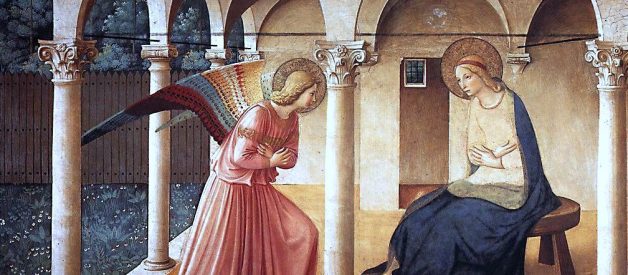Compare how different artists have depicted the Virgin Mary?s visitation from Gabriel
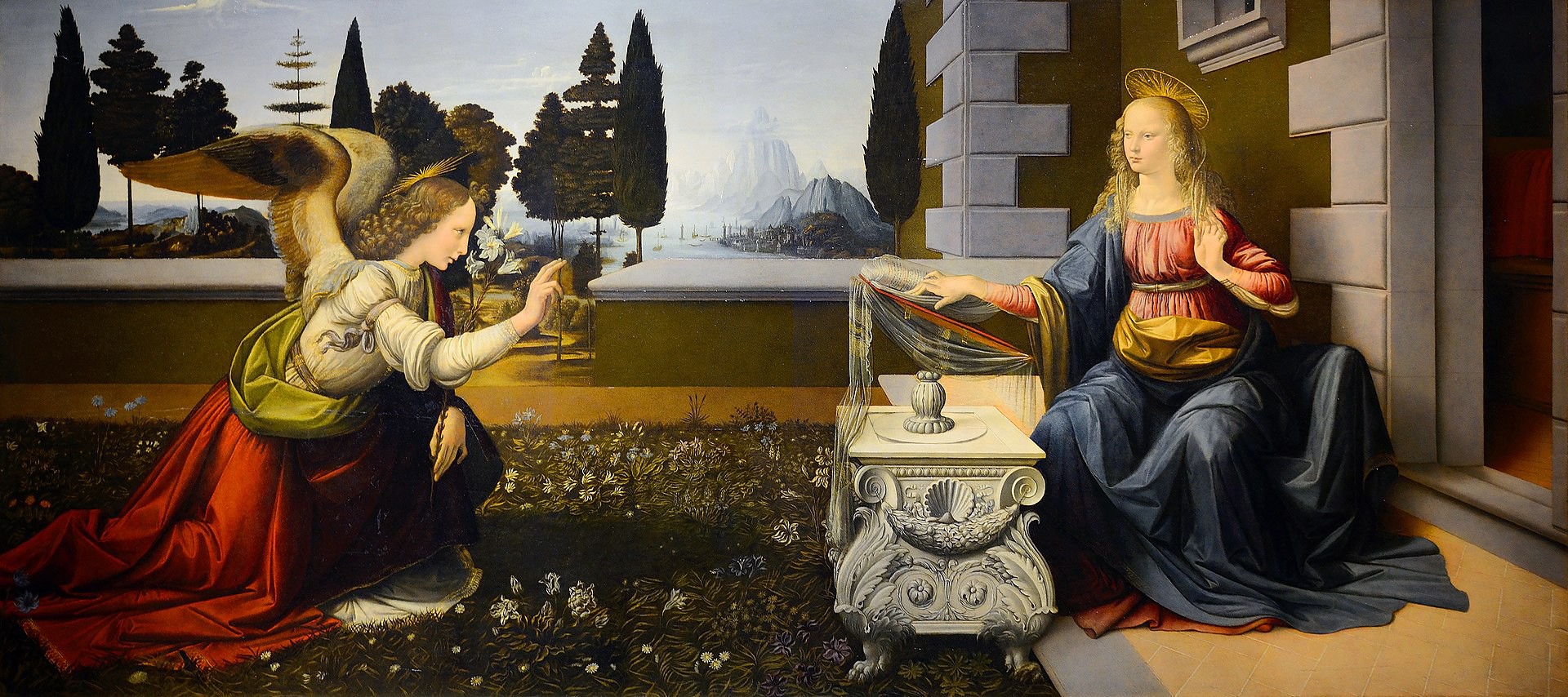 The Annunciation (circa 1472) by Leonardo da Vinci (1452?1519). Source Wikimedia Commons
The Annunciation (circa 1472) by Leonardo da Vinci (1452?1519). Source Wikimedia Commons
Leonardo da Vinci?s painting The Annunciation captures many of the most common and symbolically charged motifs of the well-known biblical story. Mary is visited by an angel as she sits inside a walled garden before a Renaissance palace, evoking the hortus conclusus (enclosed garden) that alludes to her purity.
In the Christian tradition, the Annunciation describes the moment when the angel Gabriel appeared to Mary and told her that she would become the mother of Jesus Christ. In Leonardo?s painting the angel has strong, solid wings, probably based on studies of a bird of prey, and seems to enter the image with a corporeal vigor. Mary is taken aback, perhaps exhibiting a combination of disquiet and reflection at the angel?s appearance.
The Annunciation is an important moment in the story of the New Testament, since it marked the actual incarnation of Jesus Christ ? the moment that Jesus was conceived and that the Son of God became Mary?s child. In the Bible, the Annunciation is narrated in Luke 1:26?38
?How will this be,? Mary asked the angel, ?since I am a virgin??
The angel answered, ?The Holy Spirit will come upon you, and the power of the Most High will overshadow you. So the holy one to be born will be called the Son of God. Even Elizabeth your relative is going to have a child in her old age, and she who was said to be barren is in her sixth month. For nothing is impossible with God.?
?I am the Lord?s servant,? Mary answered. ?May it be to me as you have said.? Then the angel left her.
The Annunciation became a favorite subject of artists across Europe as the veneration of the Virgin Mary grew within the Church. There are so many rich details present in paintings of the Annunciation, and every artist?s depiction is different. Yet there are a few established traditions in art that help make sense of the subject matter.
Springtime
The Incarnation of Christ is considered to have taken place at the moment of the Annunciation; that is, nine months before the Nativity. Hence, in the western liturgical calendar, the Feast of the Annunciation is celebrated on March 25th. For this reason, many artists show the scene in a springtime setting. Some artists, such as Fra Angelica, chose to emphasize the season by laying out a plethora of flowers growing in a garden.
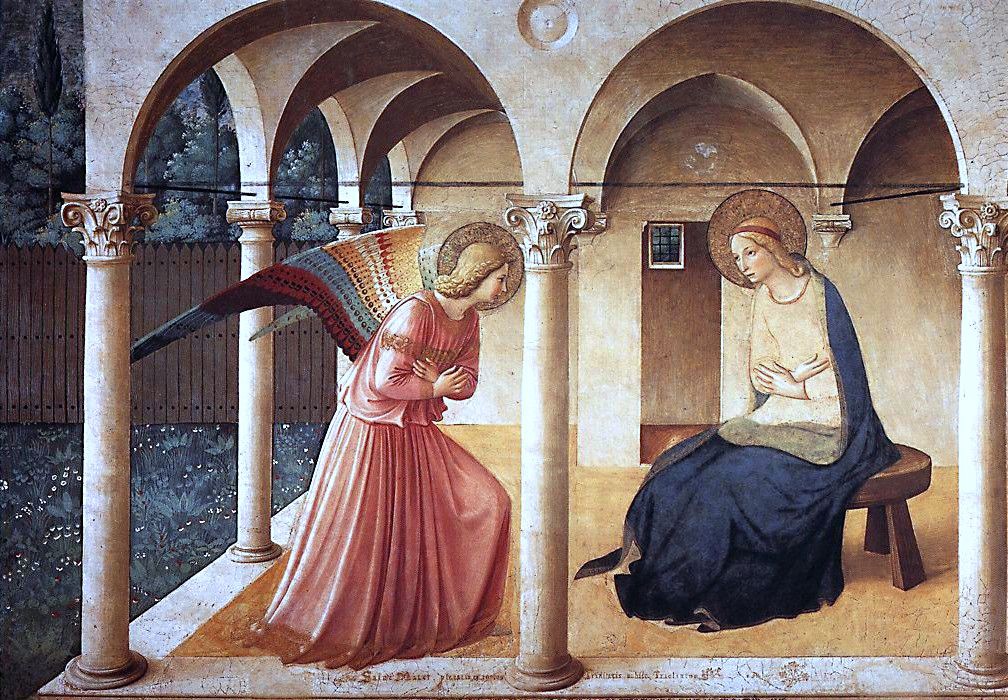 Flowers in the garden, in ?The Annunuciation? (1437-46) by Fra Angelico. Source Wikimedia Commons
Flowers in the garden, in ?The Annunuciation? (1437-46) by Fra Angelico. Source Wikimedia Commons
Alternatives to a garden became popular. The motif of a flower in a vase became well-used, a tradition that developed into a lily, which became the symbol of the Virgin?s purity. Sometimes the lily is held in Gabriel?s hand; in other paintings the lily is in a vase as part of the general setting.
 Gabriel holding a lily, symbol of Mary?s purity within a garden of springtime flowers, in ?The Annunciation? (circa 1472) by Leonardo da Vinci (1452?1519). Source Wikimedia Commons
Gabriel holding a lily, symbol of Mary?s purity within a garden of springtime flowers, in ?The Annunciation? (circa 1472) by Leonardo da Vinci (1452?1519). Source Wikimedia Commons
The Dove
A common element in paintings of the Annunciation is a dove, representing the Holy Spirit, the symbol of God as spiritually active in the world. The image is from the words of John the Baptist, ?I saw the spirit coming down from heaven like a dove and resting upon him? (John 1:32).
In Annunciation paintings, the dove is often shown descending on a ray of light, indicating the ineffable nature of the Holy Spirit and also a sense of movement or passage, with the ray of light touching the Virgin?s head or breast in the moment of Incarnation.
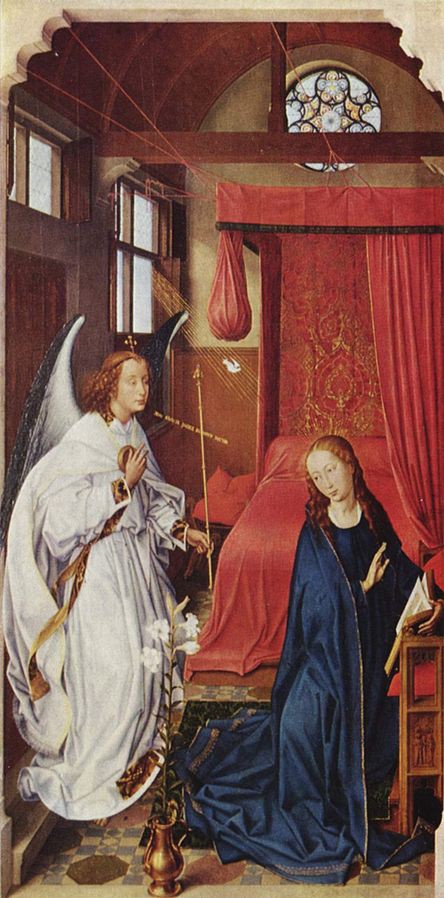 The Holy Spirit descending in the form of a dove on rays of light, in ?The Annunciation? from the Saint Columba Altarpiece (c. 1455) by Rogier van der Weyden. Source Wikimedia Commons
The Holy Spirit descending in the form of a dove on rays of light, in ?The Annunciation? from the Saint Columba Altarpiece (c. 1455) by Rogier van der Weyden. Source Wikimedia Commons
One fascinating tradition that developed in early Netherlandish art was to show the ray of light entering the scene through a window, as in Rogier van der Weyden?s painting. This was a way of alluding to the conceptually tricky idea of Mary?s miracle conception, by comparing the passage of the Holy Spirit through the body of the Virgin to light passing through glass.
The French abbot Bernard of Clairvaux likened the miracle to sunshine through a window: ?Just as the brilliance of the sun fills and penetrates a glass window without damaging it, and pierces its solid form with imperceptible subtlety, neither hurting when entering nor destroying when emerging; thus the word of God, the splendor of the Father, entered the virgin chamber and then came forth from the closed womb.?
Mary?s Posture
The posture of Mary is a detail that many artists took a great of care to depict because it gave them an opportunity to explore Mary?s psychological reaction to the presence of Gabriel.
Italian preachers, such as the famous Fra Roberto Caracciolo of Lecce, made detailed analyses of the account given by St Luke, going so far as to lay out a series of five spiritual and mental conditions that Mary went through when encountering Gabriel?s message. According to Fra Roberto, these were said to be, in order: Disquiet, Reflection, Inquiry, Submission and Merit.
Following from these categories, it?s possible to interpret the various postures of Mary as falling into one of these five mental states. As the art historian Michael Baxandall explains, ?The preachers coached the public in the painters? repertory, and the painters responded within the current emotional categorization of the event.?
So for instance, in The Cestello Annunciation (1489) by Sandro Botticelli, the posture of Mary is interpreted as according with the first of her reactions, Conturbatio or Disquiet, an expression of alarm at the appearance of the angel. According to Luke, ?Mary was greatly troubled at his words and wondered what kind of greeting this might be.?
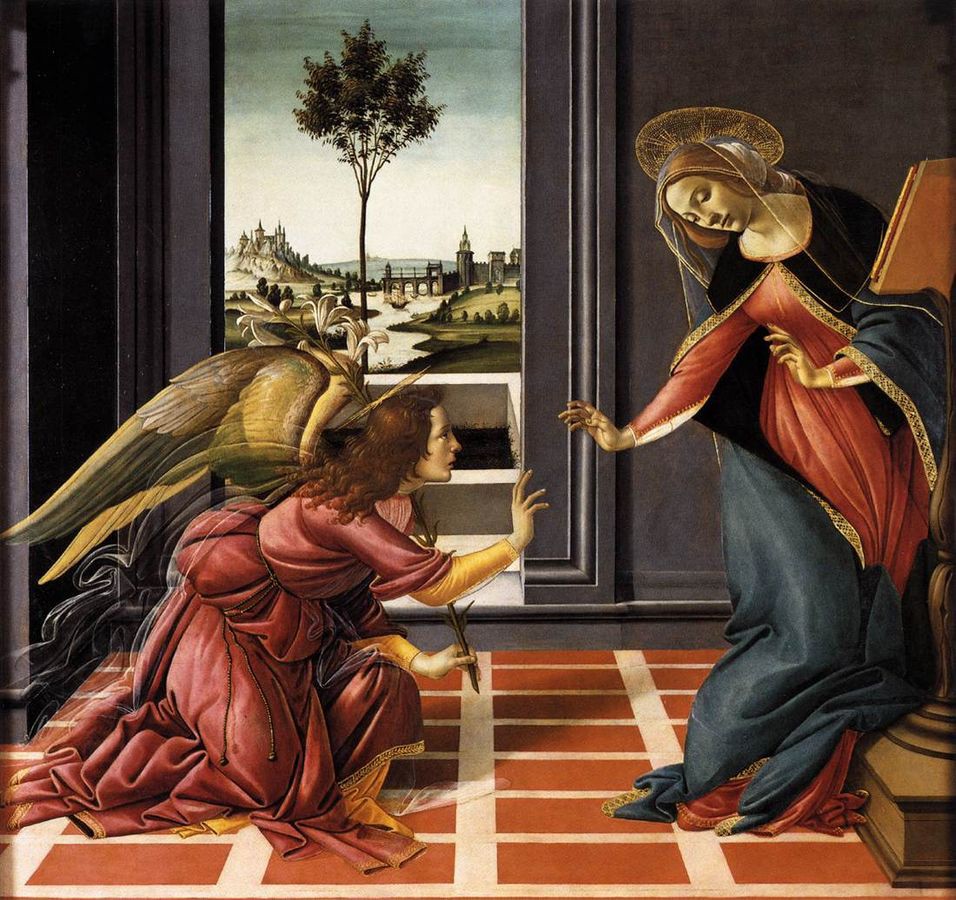 The Cestello Annunciation (1489) by Sandro Botticelli. Source Wikimedia Commons
The Cestello Annunciation (1489) by Sandro Botticelli. Source Wikimedia Commons
Alternatively, in Fra Angelico?s version, Mary?s response may be seen as Humiliatio or Submission, submitting to Gabriel?s message by ?lifting her eyes to heaven, and bringing up her hands with her arms in the form of a cross.?
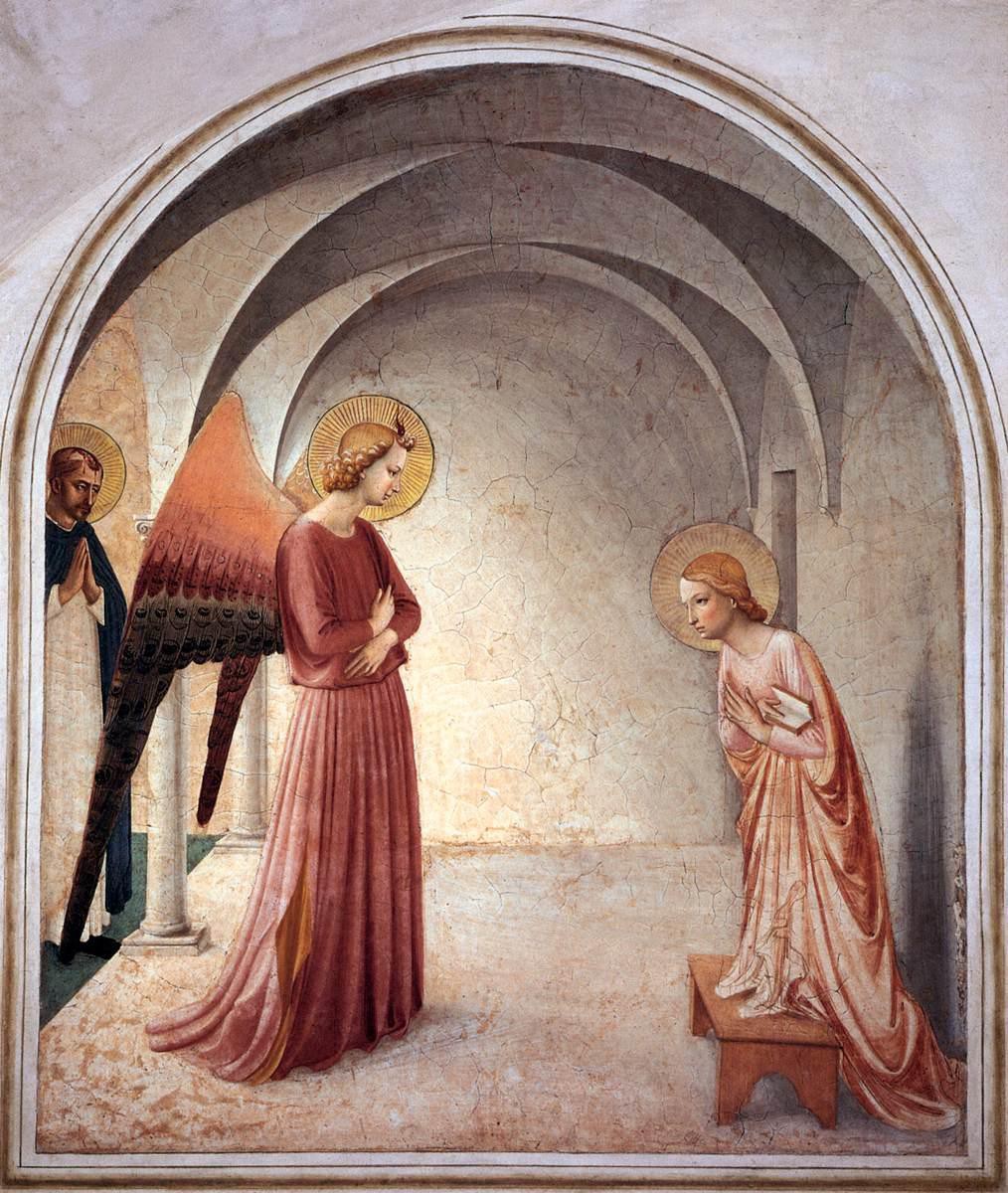 The Annunciation (1440?42) by Fra Angelico. Source WikiArt
The Annunciation (1440?42) by Fra Angelico. Source WikiArt
Architecture
The setting of paintings of the annunciation may also contain interesting symbolic meaning. Italian Renaissance artists tended to depict Mary being visited in an open space, usually a loggia (a room with open sides) or a portico (a porch with columns), as a way of including contemporary architectural detail into the work whilst also suggesting a modest, enclosed setting. The secluded space, or sometimes a walled garden or a tower, indicates Mary?s chastity.
 The Annunciation (1502?1503) by Raphael. Source WikiArt
The Annunciation (1502?1503) by Raphael. Source WikiArt
Northern European artists of the same period often showed the Virgin in an interior space, sometimes a domestic house or else an ecclesiastical context, drawing on contemporary Gothic styles to suggest the familiar setting of the Christian Church. The area in which the Virgin receives the angel is well often small and secluded, as in Matthias Grnewald?s version, which shows Mary at study in a curtained section of a church. Yet the area is well lit by windows, illuminated by the light of the Christian faith.
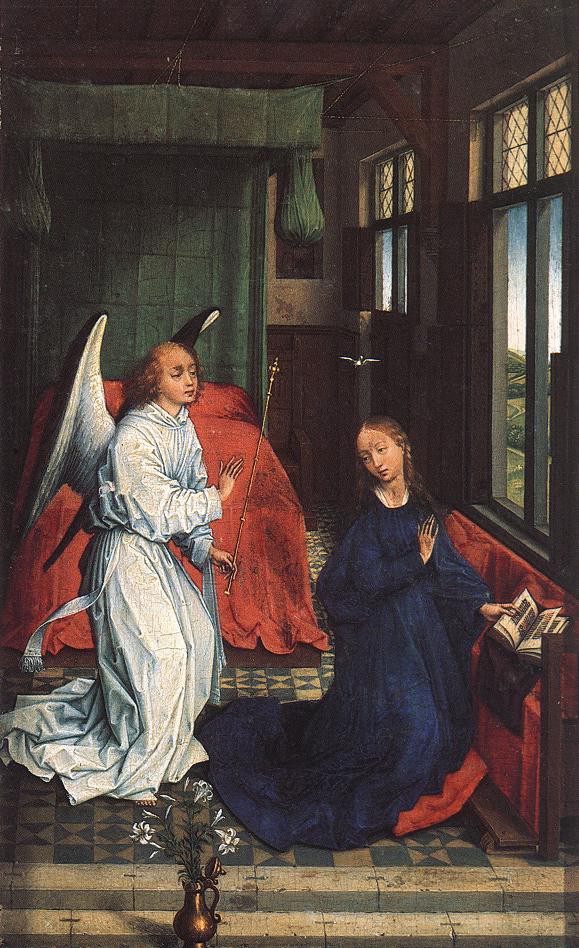
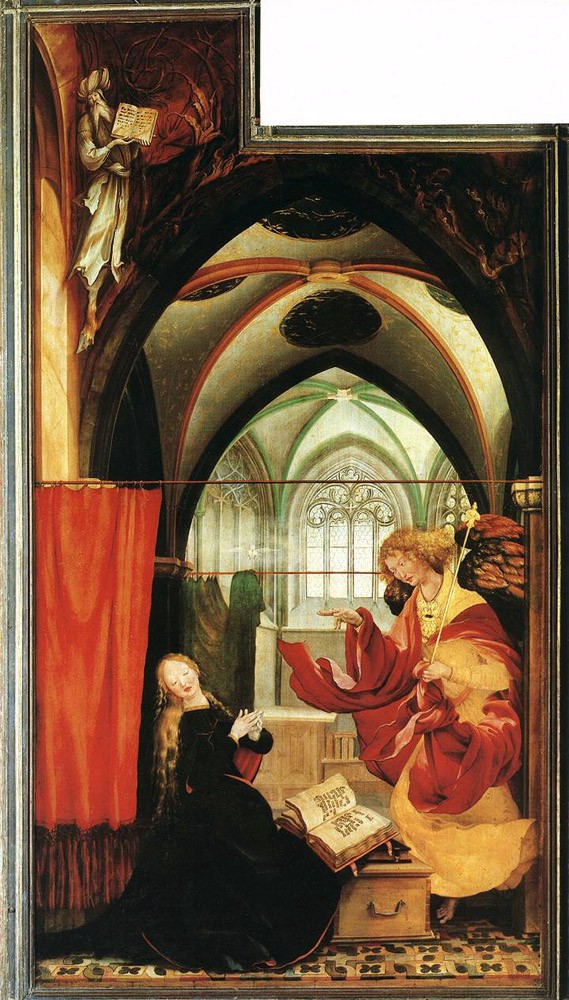 Left: The Annuciation (1440) by Rogier van der Weyden. Source WikiArt. Right: The Annunciation (left wing of the Isenheim Altar) (c.1515) by Matthias Grnewald. Source WikiArt.
Left: The Annuciation (1440) by Rogier van der Weyden. Source WikiArt. Right: The Annunciation (left wing of the Isenheim Altar) (c.1515) by Matthias Grnewald. Source WikiArt.
The Annunciation was widely represented in art from the medieval period onwards. It was also during the 13th century that the hugely influential Golden Legend appeared, a compendium of traditional stories about the saints and miracle tales, which was widely drawn upon as a sourcebook by artists of the following centuries. The story of Mary?s annunciation was retold and cemented in this book, after which its representation in European art was established beyond question. ?The feast of this day is called the Annunciation of our Lady, for on this day the angel Gabriel showed to the glorious Virgin Mary the coming of the Blessed Son of God.?

Christopher P Jones writes about culture, art and life at his website. Sign up for more.
